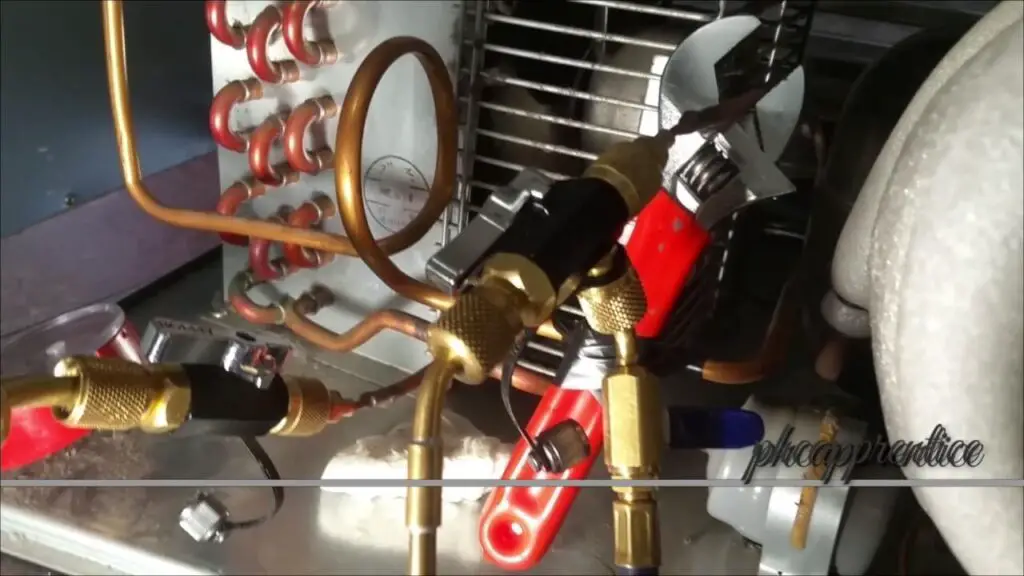Turbo Air Refrigerator Troubleshooting: Easy Fixes
If your Turbo Air refrigerator stops cooling, check for common issues like a switched-off power source, an improperly set thermostat, blocked vents, dirty condenser coils, dirty or faulty gaskets, insufficient space clearance, or a broken or stuck condenser fan. These problems can disrupt the cooling function and can be easily resolved.
Cleaning the condenser coils and gaskets, ensuring proper power connection, and clearing the vents can often fix the issue. However, if the problem persists, it may require professional troubleshooting to pinpoint any internal malfunctions or to replace faulty parts. Proper maintenance and regular cleaning can help prevent such issues in the future.

Checking The Power Source
When it comes to troubleshooting a Turbo Air refrigerator, one of the first areas to check is the power source. Without a functional power source, the refrigerator will not be able to cool properly. Follow the steps below to ensure that the power source is switched on and that the electrical outlet is functioning correctly.
Ensure The Power Source Is Switched On
Before proceeding with any troubleshooting steps, it’s important to check that the power source of the Turbo Air refrigerator is switched on. This may seem like an obvious step, but occasionally the power switch can inadvertently get turned off or bumped during cleaning or maintenance.
If you find that the Turbo Air refrigerator is not running at all, make sure to locate the power switch, usually located near the appliance, and ensure that it is turned on. If the power switch is already on, move on to the next step.
Verify The Electrical Outlet Is Functioning Properly
After confirming that the power source is switched on, the next step is to verify that the electrical outlet is functioning correctly. A faulty electrical outlet can prevent the Turbo Air refrigerator from receiving the necessary power to cool effectively.
To check the electrical outlet, follow these steps:
- Unplug the Turbo Air refrigerator from the outlet.
- Plug in a different appliance or device into the same outlet to verify if it is working.
- If the alternate device does not receive power, the outlet may be the issue. In this case, try plugging the Turbo Air refrigerator into a different outlet to see if it works.
- If the alternate device does receive power, the issue may lie with the Turbo Air refrigerator itself. Further troubleshooting steps will be necessary.
By following these steps, you can quickly determine whether the power source is the culprit of the Turbo Air refrigerator’s malfunction. If the issue persists after checking both the power source and the electrical outlet, it may be necessary to consult a professional for further assistance.
Adjusting The Thermostat Settings
One of the most crucial aspects of troubleshooting a Turbo Air refrigerator is adjusting the thermostat settings. Ensuring that the thermostat is set to the appropriate temperature is essential for optimal performance and energy efficiency. In this section, we will discuss how to set the thermostat to the appropriate temperature and how to ensure it is not set too low or too high.
Set The Thermostat To The Appropriate Temperature
To set the thermostat to the appropriate temperature, follow these steps:
- Locate the thermostat control panel on your Turbo Air refrigerator. This is usually located on the top or side of the unit, depending on the model.
- Turn the thermostat knob or press the buttons to adjust the temperature setting. Refer to the user manual for the recommended temperature range.
- Set the thermostat to the desired temperature by aligning the indicator with the corresponding temperature mark on the control panel.
- Once set, wait for a few hours to allow the refrigerator to reach the new temperature.
Make Sure The Thermostat Is Not Set Too Low Or Too High
Setting the thermostat too low or too high can cause various issues with your Turbo Air refrigerator. Here are some guidelines to ensure the thermostat is properly adjusted:
- Avoid setting the thermostat at extremely low temperatures, as this can lead to excessive energy consumption.
- Setting the thermostat too high can put a strain on the compressor and lead to inefficient cooling.
- Check the recommended temperature range in your user manual and set the thermostat accordingly.
- Keep in mind that the ideal temperature for refrigeration is typically between 37°F and 40°F (2.8°C and 4.4°C).
By setting the thermostat to the appropriate temperature and avoiding extreme settings, you can ensure that your Turbo Air refrigerator operates efficiently and maintains optimal cooling performance.
Clearing Blocked Vents
One of the common issues that may arise with your Turbo Air Refrigerator is the presence of blocked vents. When the vents are blocked, it restricts the airflow and can lead to inefficient cooling or even the complete failure of the refrigerator. To avoid such problems, it’s crucial to periodically check the vents and ensure they are free from any obstructions. In this section, we will discuss how to clear the blocked vents effectively.
Check For Any Obstructions In The Vents
To begin troubleshooting the blocked vents, visually inspect the refrigerator’s vents to see if there are any obstructions. Here are the steps to follow:
- Turn off the refrigerator and unplug it from the power source.
- Locate the vents, which are usually located in the freezer compartment and at the back of the refrigerator.
- Inspect the vents for dust, debris, or any items that might be blocking the airflow.
Remove Any Debris Or Items Blocking The Airflow
If you notice any obstructions in the vents, it’s essential to remove them to restore proper airflow. Follow these steps to clear the blocked vents:
- Use a soft brush or a vacuum cleaner with a brush attachment to gently remove any dust or debris from the vents.
- If any items are blocking the vents, carefully remove them. Be cautious not to damage the vents or any delicate components.
- Once the vents are clear, plug the refrigerator back into the power source and turn it on.
Note: It’s important to clean the vents regularly to prevent the accumulation of dust and debris, which can lead to blocked vents and subsequent cooling issues. Consider incorporating this as part of your routine maintenance tasks to ensure optimal performance of your Turbo Air Refrigerator.
Cleaning The Condenser Coils
Inspect The Condenser Coils For Dirt And Dust Buildup
When it comes to troubleshooting a Turbo Air refrigerator, one common issue that can affect its cooling performance is a dirty or clogged condenser coil. Over time, these coils can become covered in dirt, dust, and debris, hindering their ability to release heat effectively. Inspecting the condenser coils regularly is an important maintenance task that can help prevent cooling problems.
To inspect the condenser coils, you’ll need to locate them on the back or bottom of your Turbo Air refrigerator. Carefully remove any protective grilles or covers to gain access to the coils. Take a close look at the coils and check for any signs of dirt or dust buildup. If you notice a significant amount of buildup, it’s time to clean them to ensure optimal cooling performance.
Clean The Coils Using A Vacuum Or Brush
Cleaning the condenser coils is a relatively simple process that can be done using a vacuum cleaner or a brush. Before you begin cleaning, make sure to unplug your refrigerator from the power source to ensure your safety.
If you choose to use a vacuum cleaner, use the brush attachment to gently remove any loose dirt or dust from the coils. Be careful not to damage the delicate fins of the coils while doing so. The suction power of the vacuum will help effectively remove the debris.
Alternatively, you can use a brush with soft bristles to manually clean the coils. Start by gently brushing the coils to dislodge any dirt or dust. Make sure to brush in the direction of the fins to avoid bending or damaging them. Once the loose debris is removed, use the vacuum cleaner to fully clean up the dirt and dust.
Remember to clean both sides of the condenser coils thoroughly. It’s also a good practice to clean the surrounding areas to prevent any debris from falling back onto the coils.
By regularly cleaning the condenser coils of your Turbo Air refrigerator, you can ensure optimal cooling performance and extend the lifespan of your appliance. Keep in mind that cleaning the coils should be done at least every six months or more frequently if you notice a significant buildup of dirt and debris. Taking the time to perform this maintenance task will help keep your refrigerator running efficiently and prevent potential cooling issues in the future.
Replacing Faulty Gaskets
Examine The Gaskets For Signs Of Wear Or Damage
When it comes to maintaining the performance of your Turbo Air refrigerator, one of the key areas to focus on is the gaskets. These rubber seals are responsible for creating an airtight seal between the door and the refrigerator cabinet, ensuring that cold air stays inside and warm air stays out. Over time, gaskets can become worn or damaged, compromising their ability to create a proper seal. This can lead to temperature fluctuations, increased energy consumption, and potential food spoilage.
To troubleshoot a faulty gasket, start by inspecting it for signs of wear or damage. Look for any visible cracks, tears, or deformities in the rubber. Pay close attention to the areas where the gasket comes into contact with the refrigerator door and cabinet, as these are common areas of wear. Additionally, feel for any areas that feel loose or detached, as this indicates that the gasket is no longer properly adhering to the door.
Replace Any Faulty Gaskets To Ensure A Proper Seal
If you find any faults with the gasket during your examination, it’s important to replace it as soon as possible to maintain the proper functioning of your Turbo Air refrigerator.
The process of replacing a faulty gasket may vary depending on the specific model of your Turbo Air refrigerator, but generally, it involves the following steps:
- Obtain a replacement gasket that is compatible with your Turbo Air refrigerator model. Contact your manufacturer or consult the refrigerator’s manual for information on where to purchase the correct gasket.
- Before installing the new gasket, make sure to thoroughly clean the area where it will be attached. Use a mild detergent and warm water to remove any dirt, grease, or residue that may interfere with the adhesion of the new gasket.
- Carefully remove the old gasket by loosening the screws or clips that secure it to the door. Take note of the original positioning of the gasket to ensure proper alignment of the replacement.
- Align the new gasket with the door and secure it in place using the screws or clips provided. Make sure to tighten them evenly to ensure a snug fit.
- Once the new gasket is installed, close the refrigerator door and check for proper alignment and sealing. Test the door’s closure by gently pulling on it to create slight resistance. If it creates a slight vacuum, you have successfully replaced the faulty gasket.
By regularly examining and replacing faulty gaskets, you can ensure that your Turbo Air refrigerator maintains an optimal temperature, operates efficiently, and preserves the quality of your stored food.
Providing Adequate Space Clearance
Verify That The Refrigerator Is Properly Spaced From The Wall Or Other Objects
One of the common issues that can affect the performance of your Turbo Air refrigerator is inadequate space clearance. By ensuring that your refrigerator is properly spaced from the wall or other objects, you can maximize its efficiency and cooling capabilities. Here are a few key considerations:
- Check the outlet connection. Before delving into the space clearance, it’s important to ensure that the power connection is proper. Verify that the unit is plugged in fully and that there are no loose connections.
- Measure the clearance: Take a tape measure and measure the distance between the back of the refrigerator and the wall. Turbo Air recommends leaving at least 2–3 inches of clearance to facilitate proper airflow.
- Avoid obstructing objects: Make sure there are no obstructions, such as cabinets or shelves adjacent to the refrigerator. These can restrict airflow and impede the cooling process.
- Consider side and top clearance: In addition to the back clearance, it’s crucial to allow adequate space on the sides and above the refrigerator. Turbo Air suggests leaving at least 1-2 inches of clearance on each side and the top for optimal performance.
By adhering to Turbo Air’s recommendations on space clearance, you can ensure that your refrigerator functions at its best. This can help prevent issues such as temperature fluctuations, inadequate cooling, and increased energy consumption.
Allow Sufficient Clearance For Optimal Airflow
In order to maintain optimal performance, it’s important to allow sufficient clearance for airflow around your Turbo Air refrigerator. Here’s why:
- Promotes efficient cooling: Adequate airflow helps dissipate heat from the condenser coils, allowing the refrigerator to cool efficiently. When there isn’t enough clearance, heat can get trapped and lead to temperature imbalances.
- Prevents compressor strain: Insufficient airflow can cause the compressor to work harder, leading to increased energy consumption and potential compressor malfunction. By allowing proper clearance, you can extend the lifespan of your refrigerator.
- Reduces the risk of condensation: When there’s limited airflow, condensation may form inside the refrigerator, leading to moisture buildup and potential damage to food items. Optimal airflow helps reduce the risk of condensation.
To ensure optimal airflow, it’s crucial to regularly clean the condenser coils and maintain the recommended space clearance. By doing so, you can enhance the efficiency and longevity of your Turbo Air refrigerator while keeping your food items fresh and cold.
Frequently Asked Questions
What to Check If the Refrigerator Stops Cooling?
If your refrigerator stops cooling, here are some things to check: power source, thermostat settings, blocked vents, dirty condenser coils, and faulty gaskets. Make sure there is enough space clearance and check if the condenser fan is broken or stuck.
Why is my refrigerator not getting cold?
If your refrigerator isn’t getting cold, there are several possible causes: a power source switched off, a thermostat not set properly, blocked vents, dirty condenser coils, dirty or faulty gaskets, not enough space clearance, or a broken or stuck condenser fan. Check these issues to troubleshoot.
What Kind of Freon Does a Turbo Air Refrigerator Use?
A Turbo Air refrigerator uses R-290 as its kind of Freon.
What Does Df Mean On A Turbo Air Freezer?
DF on a Turbo Air freezer stands for defrost mode. It is when the air conditioner switches to a cycle to remove frost from the outside coil. This typically occurs after the system has been operating in reverse mode as a room heater for a while in cold weather.
Why is my refrigerator not getting cold?
There are several causes for a refrigerator that doesn’t cool, including dirty condenser coils, poor ventilation, improper installation, faulty or dirty gasket seals, unorganized food storage, appliance location, and malfunctioning internal parts.
Conclusion
To troubleshoot your Turbo Air refrigerator, there are a few common issues you can check for. First, ensure that the power source is switched on and the thermostat is set properly. Blocked vents, dirty condenser coils, and faulty gaskets can also cause cooling problems.
Additionally, make sure there is enough space clearance and that the condenser fan is not broken or stuck. By addressing these issues, you can potentially fix the problem and keep your refrigerator running smoothly. Don’t forget to consult the Turbo Air refrigerator manual for further guidance.




